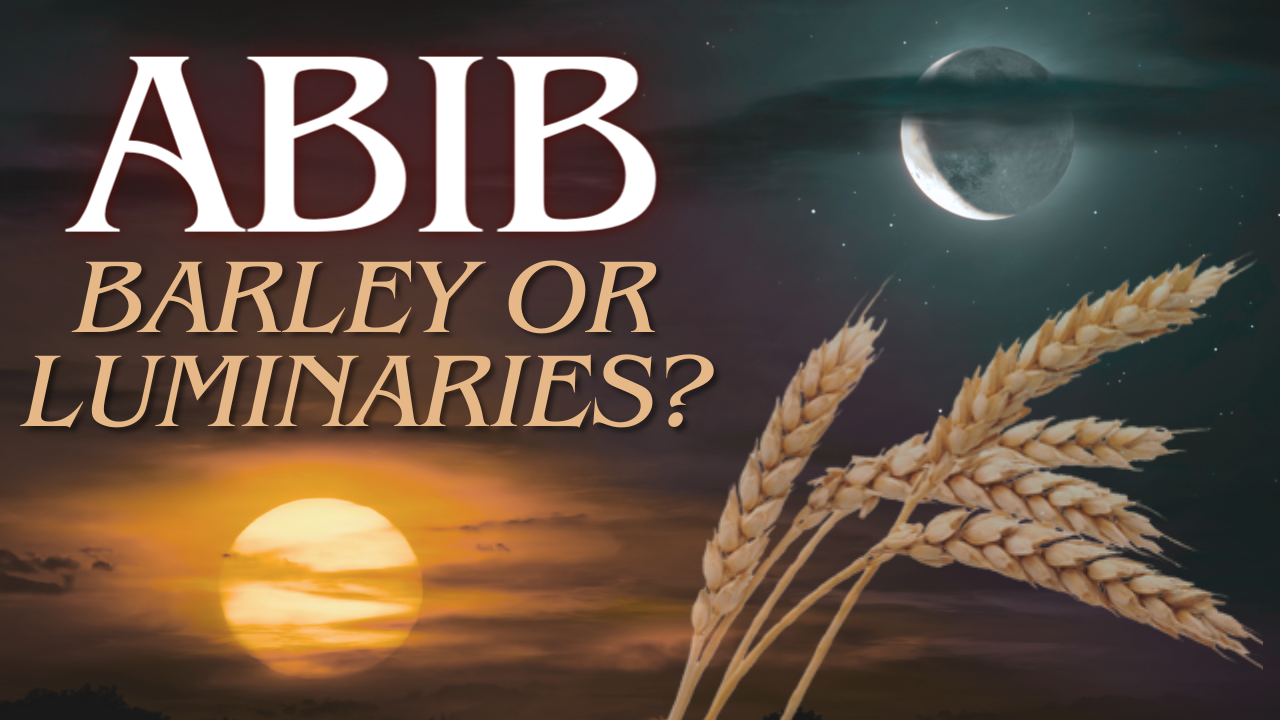
Spring has finally sprung, what an amazing time of the (new) year! After the dreary months of winter, spring is certainly welcomed for many reasons. Warmth returns, the abundant rain, plant life, and much more. Also around this time, many discussions within the assembly of YHWH arise regarding the calendar. Specifically, these exchanges are centered around the calculation of the new year, Abib.
And YHWH spake unto Moses and Aaron in the land of Egypt saying, This month shall be unto you the beginning of months: it shall be the first month of the year to you
Exodus 12:1-2

For those unaware, the Hebrew calendar is not the same as the Gregorian, which is what the secular world operates on. The Hebrew new year actually occurs in the March to April time frame, not January 1st as we have been accustomed to. Nevertheless, disputes emerge on the application of how Abib 1 is ‘observed’, or determined. The modern-day Jewish method involves the observation of the ripening barley to determine the new month. This study will be examining this practice in great detail, comparing it with scripture. After all, we are instructed to remove the leaven from our homes, which we have learned is not purely a physical exercise, but spiritual and doctrinal in nature also.
How is it that you do not understand that I spoke it not to you concerning bread, that you should beware of the leaven of the Pharisees and of the Sadducees? Then understood they how that he bade them not beware of the leaven of bread, but of the doctrine of the Pharisees and of the Sadducees.
Matthew 16:11-12
Our goal with this study to examine the standard practice, compare it to the Word and make sure we are doing things according to His commands, and not the traditions of men.
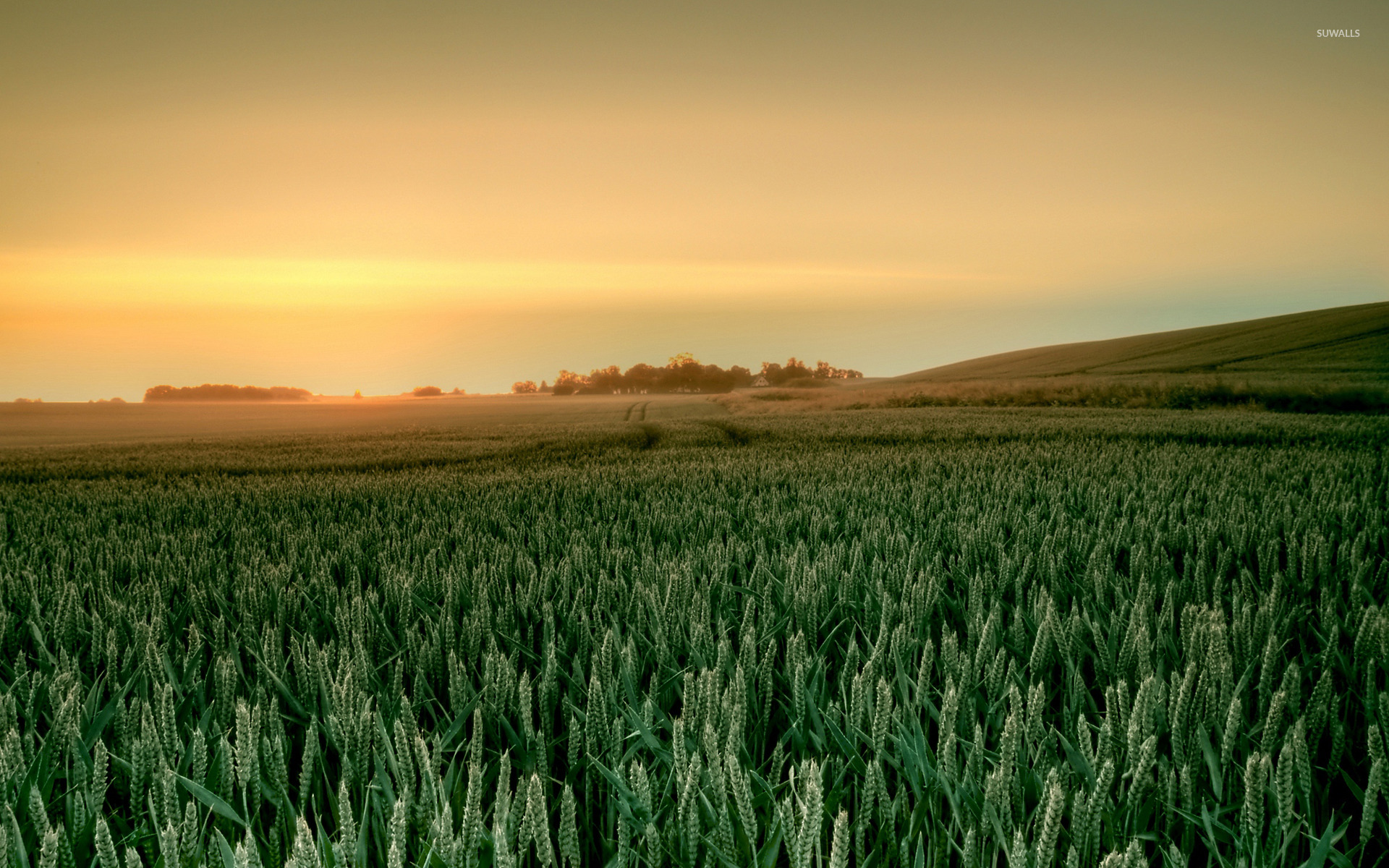
Let us begin with this; the study we are about to embark on is not intended to cause division, but is put forth in love. Even though calendar disputes arise, I believe true maturity in the word is demonstrated by brothers and sisters discussing these matters in love, even when we disagree. So with that being said, let’s examine the verses used to promote the observance of the ripened barley as the pillar we are to stand in in regards to the calendar.
Observe the month of Abib, and keep the Passover unto YHWH your Elohim: for in the month of Abib YHWH your Elohim brought you forth out of Egypt by night.
Deuteronomy 16:1
What is the month Abib?
And the flax and the barley was smitten: for the barley was in the ear, and the flax was bolled. But the wheat and the rye were not smitten: for they were not grown up.
Exodus 9:31-32

This can be no other time than spring, when the barley does in-fact ripen. Now, let’s dive deeper into the word ‘observe’:
“Observe the month of Abib“
Observe: (Hebrew word Shamar)
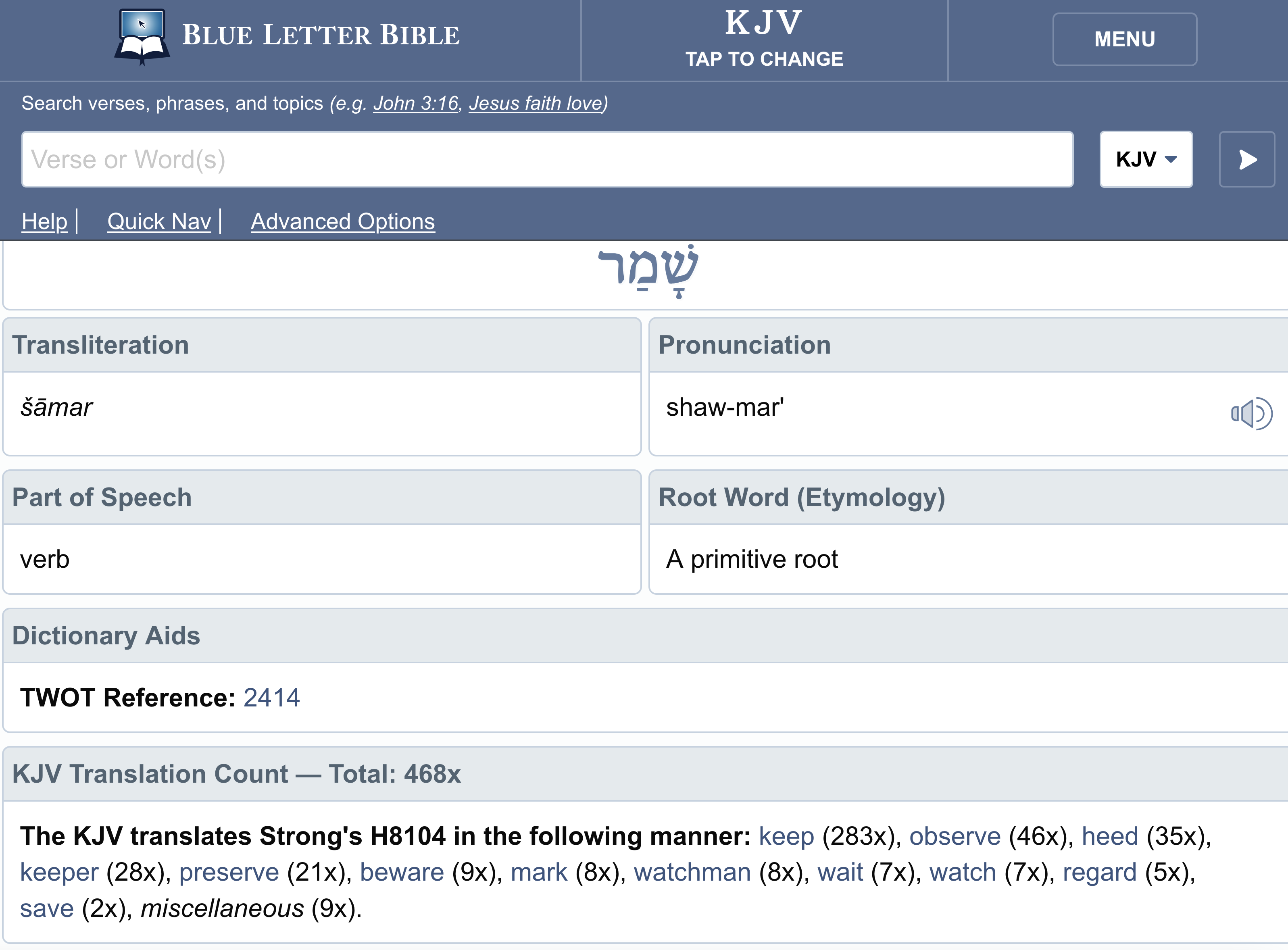
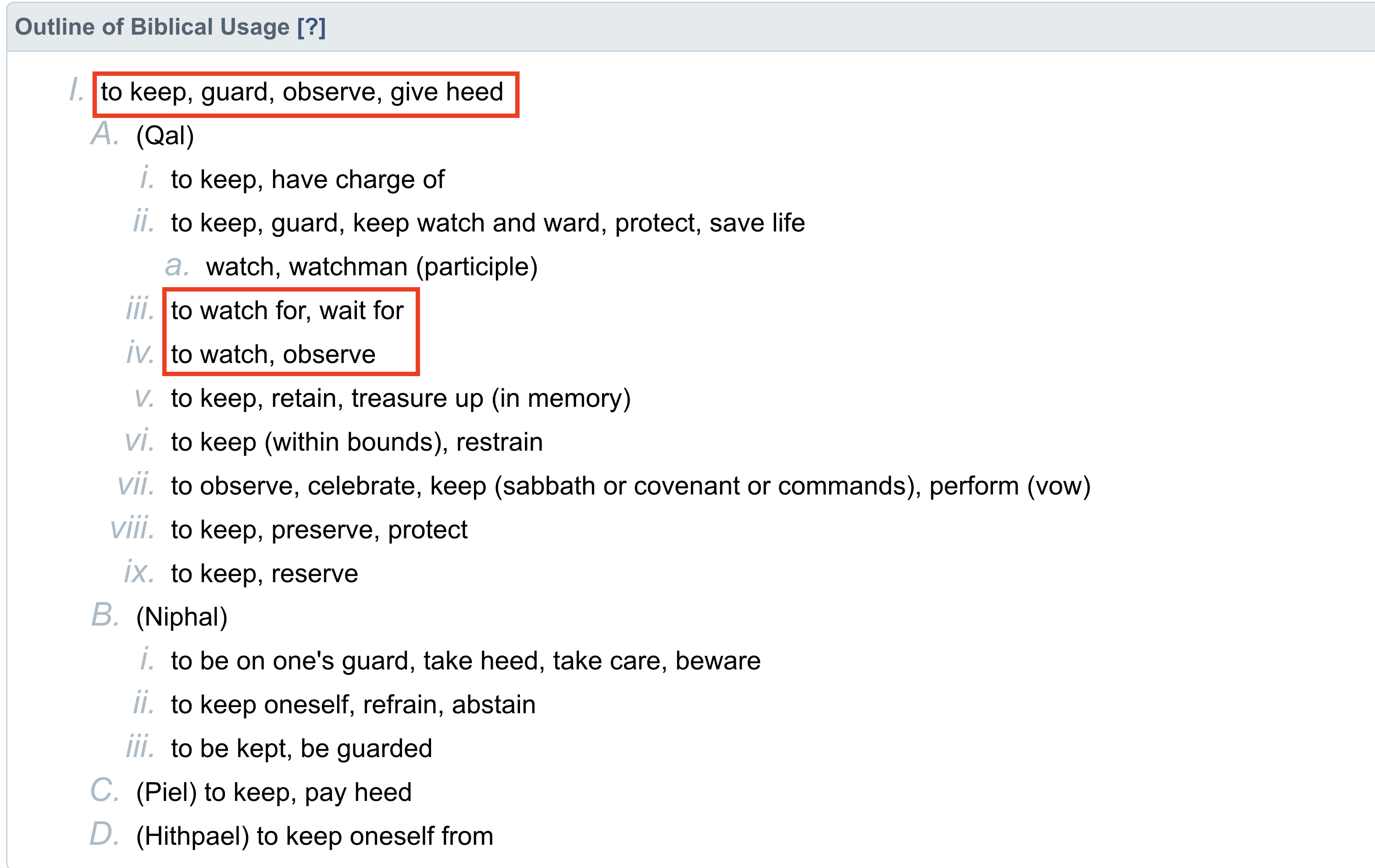

Shamar is the same word used in context with the commandments:
Keep (shamar) my commandments, and live; and my Torah as the apple of your eye
Proverbs 7:2
We are to be on watch, guarding and observing YHWH’s signs and witnesses, to properly indicate the month of Abib. Let’s take a look at Abib now:
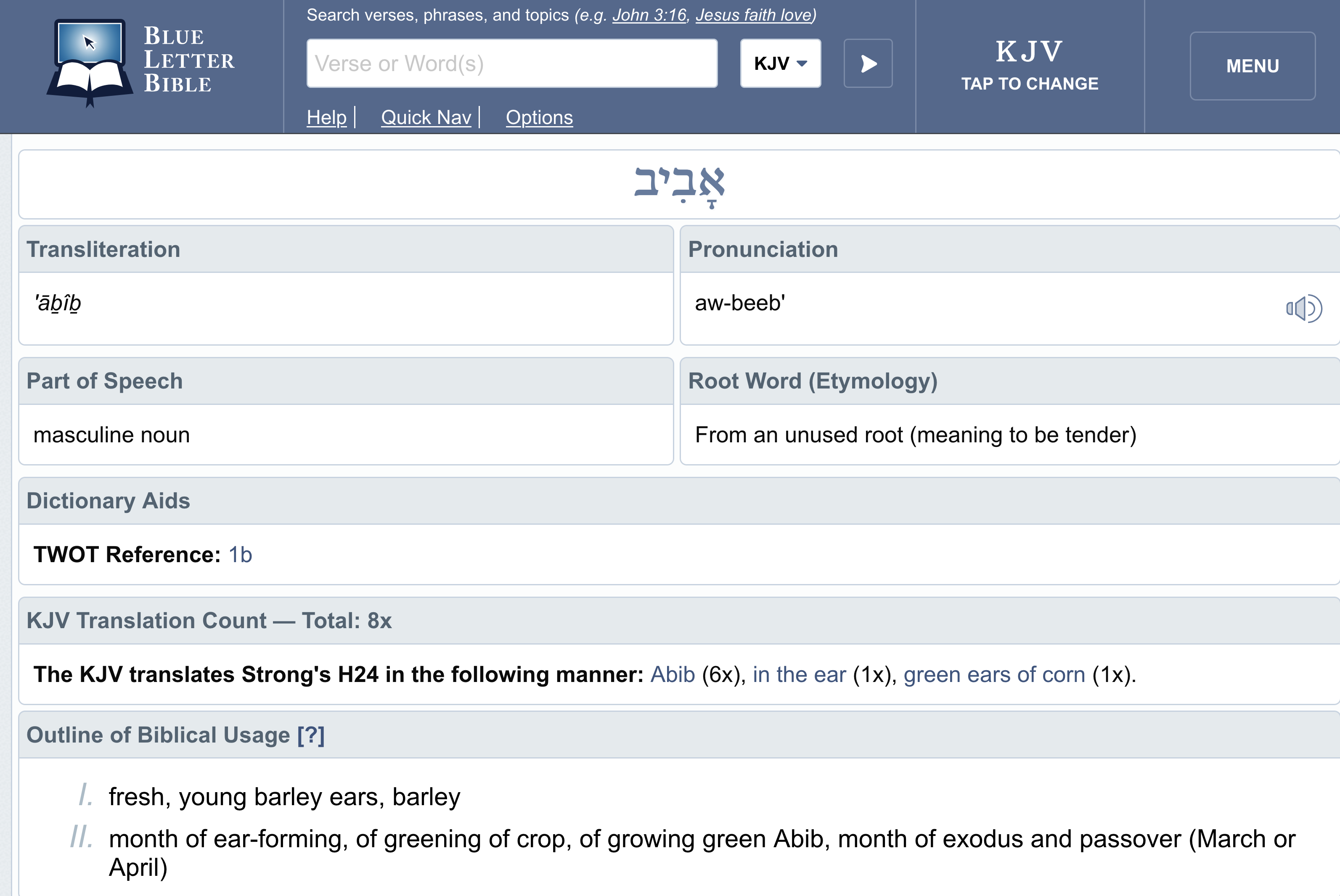

There is much deliberation regarding what Abib actually means among scholars. Many of the modern-day interpretations include the present Jewish traditions. However, it is generally accepted as the time of spring, when plants become tender, ear forming and early crops mature (barley). One thing we do know, is barley itself has it’s own Hebrew word:
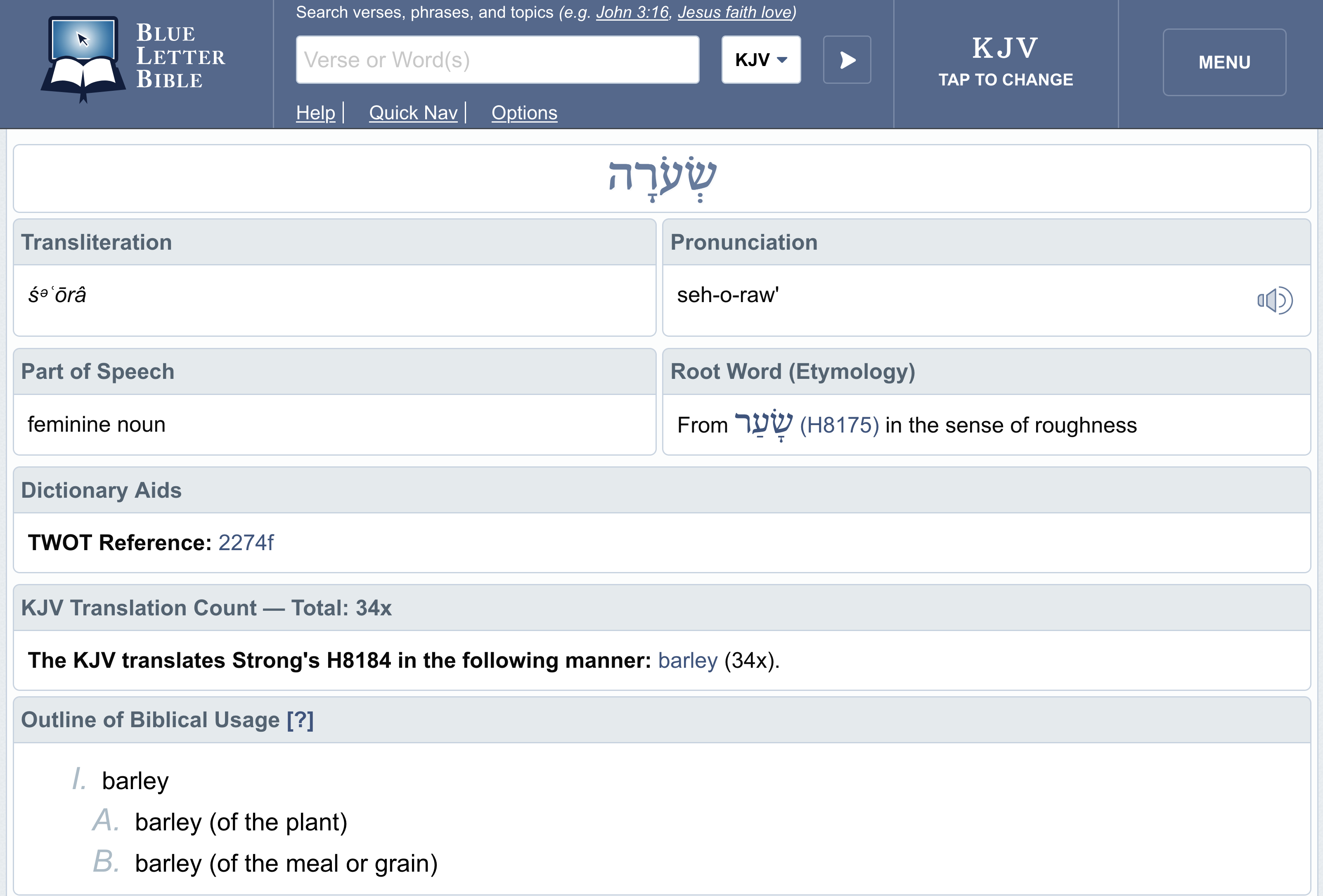
If the command to ‘observe Abib’ was just about looking at the barley, YHWH could have just used sehora and made things much clearer. However, as we know, the word for barley was not used here.
Here’s the real question, did YHWH command us to observe plants
in relation to his calendar? Days, months, years?

And Elohim said, Let there be lights in the firmament of the heaven to divide the day from the night; and let them be for signs, and for seasons, and for days, and years: And let them be for lights in the firmament of the heaven to give light upon the earth: and it was so. And Elohim made two great lights; the greater light to rule the day, and the lesser light to rule the night: he made the stars also.
Genesis 1:14-16
YHWH gave us the two luminaries, the sun and moon for seasons (Hebrew word Moed – appointed times, festivals), and for days and years.

So teach us to number our days, that we may apply our hearts unto wisdom
Psalm 90:12
YHWH gave us the sun and moon to number our days. How would we be able to lean on barley if there was a drought, or famine in the land? Here’s some more evidence to consider:
It shall be established for ever as the moon, and as a faithful witness in heaven. Selah.
Psalm 89:37
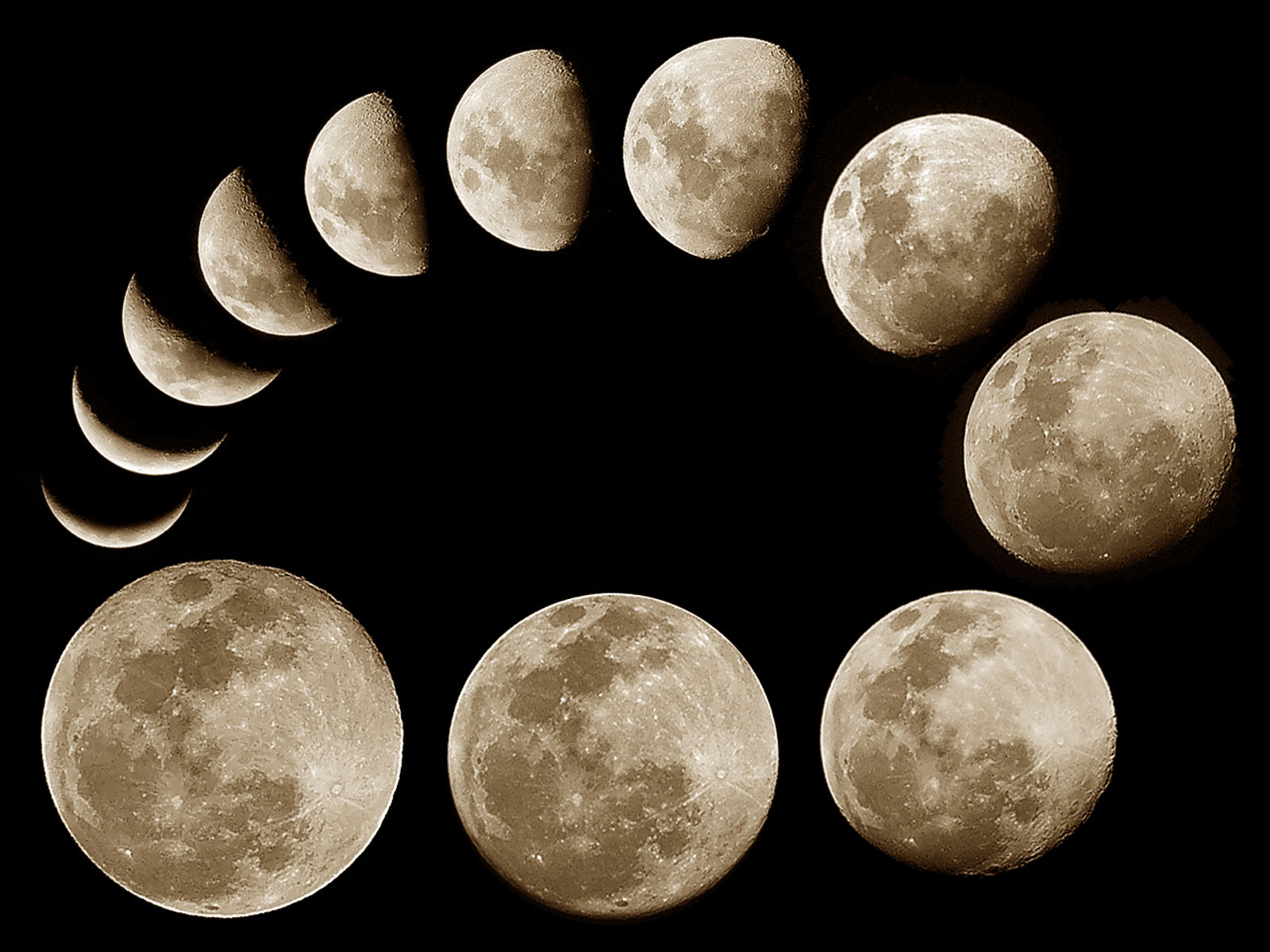
The moon, alongside the sun are witnesses in the heavens. These two integral pieces of YHWH’s calendar are untouchable and unalterable by man. Unharmed by inclement weather, drought, or famine. Something plants do not share in common.
He appointed the moon for seasons (moedim – appointed feasts): the sun knows his going down
Psalm 104:19
Nowhere in scripture does YHWH tell us crops are to be used for his calendar, only the luminaries which are not susceptible to manipulation, foul weather and many other factors.
Next, we will read from The Book of Sirach, also known as Ecclesiasticus. This book was included in the Greek Septuagint, which was the predominant ‘canon’ or bible during the time of Messiah and his disciples. Sirach was also included in the 1611 KJV, Geneva Bibles, the Latin Vulgate, and others. Although not included in the 66 book canon, this volume is considered scripture by many of YHWH’s people.
He made the moon also, to serve in its season to mark the times and to be an everlasting sign. From the moon comes the sign for feast days, a light that wanes when it has reached the full. The month is named for the moon, increasing marvelously in its phases, an instrument of the hosts on high shining forth in the firmament of heaven.
Sirach 43:6-8
The moon serves as a witness to YHWH’s heavenly clock above. The moon is the main indicator of months and consequently, the feast days. Recently, some have said the word Chodesh is not related to the moon, however, scripture tends to disagree with this. Let us authenticate what the Book of Sirach just stated. Here’s the Hebrew word for moon:

Now here is Yerah (compare to Yareach – “The month is named after the moon”)
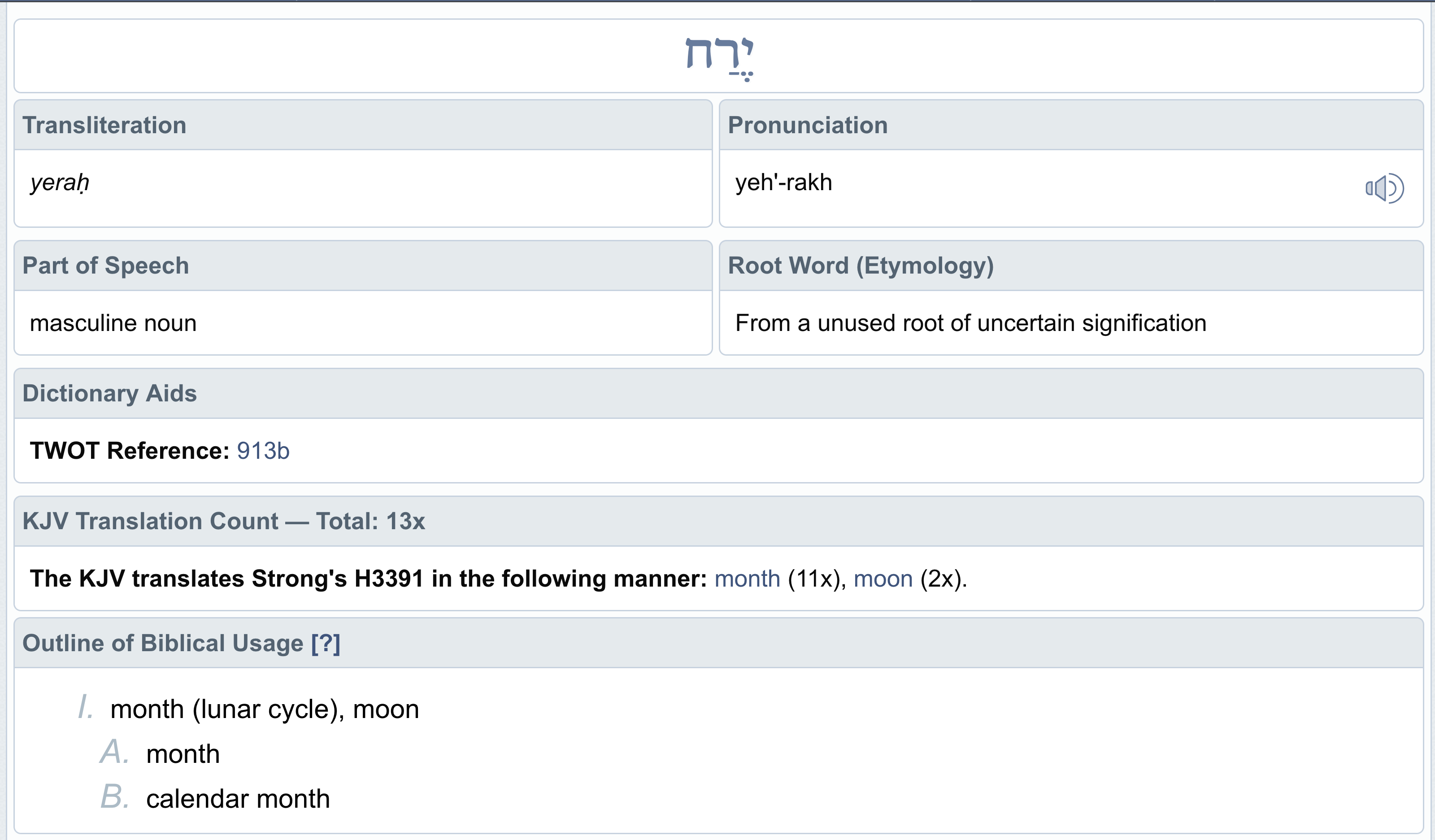
Here is how it is used
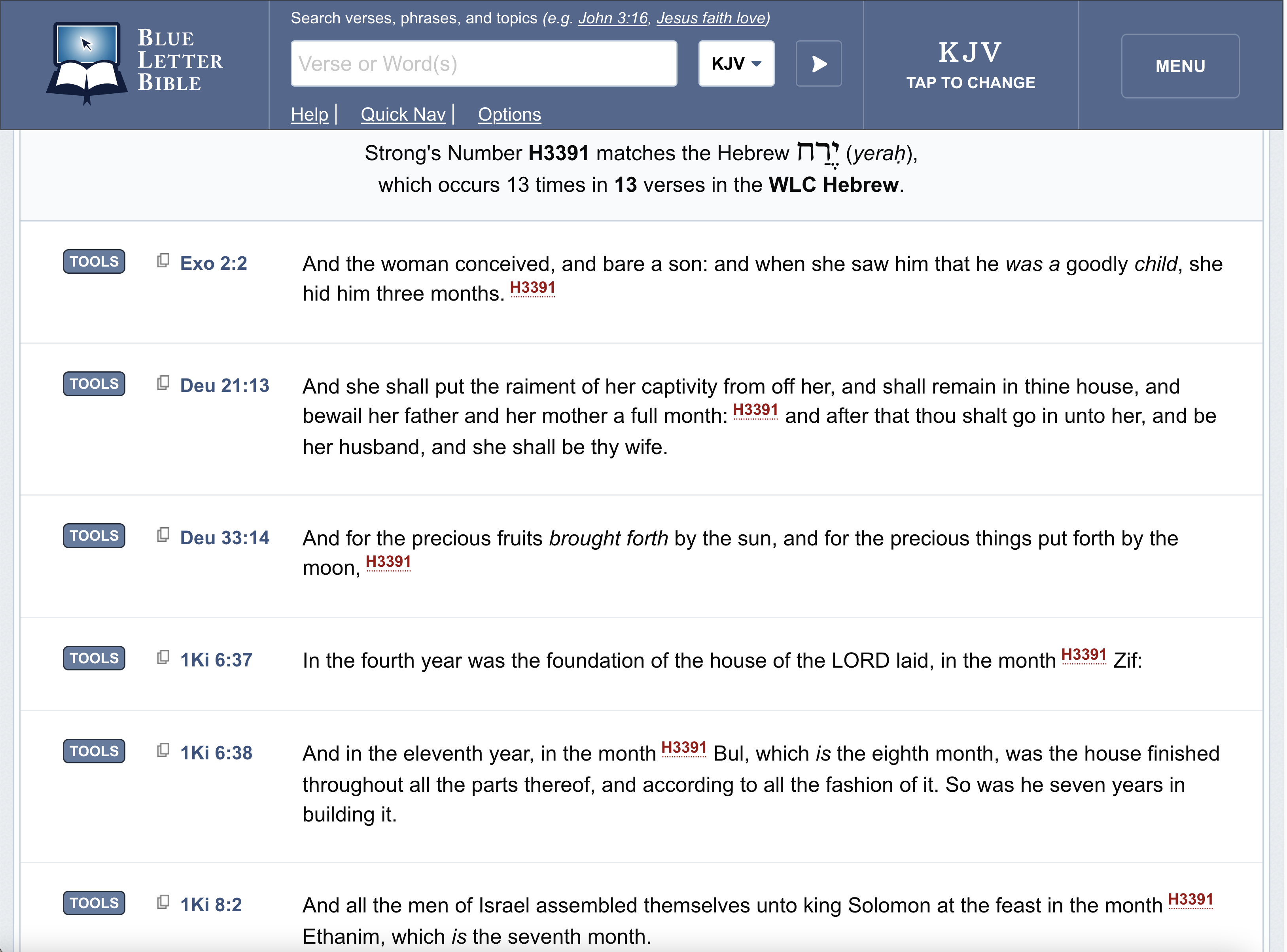
Scripturally, the moon is used for the months and is a faithful witness above.
Thus says YHWH, Who gives the sun for light by day And the fixed order of the moon and the stars for light by night, Who stirs up the sea so that its waves roar; YHWH of Hosts is His name:
Jeremiah 31:35
I may be wrong, but the scriptures teach us that the sun and moon are witnesses in the heavens that we can depend on. We believe that when the calendar is properly observed using the luminaries, the seasons will always be kept in the correct cycles; the barley will always be ready. Diligent observers of the heavenly bodies quickly realize every luminary above follows a pattern without fail. As we will uncover shortly, we believe the scriptural way to ‘observe Abib’ is by using the sun and moon to determine the beginning of the year. When observed in this way, we are ensured we are in the correct season for harvesting. We believe the true new year happens after the sun has crossed the equinox and the new moon following has been spotted.
1ST ENOCH & THE CALENDAR

As we displayed just a moment ago, the 66 book canon (protestant bible) is filled with clues pertaining to the calendar. However, it’s evident that all the inter-workings; how the sun and moon are actually used in the calculations, are not elaborated within the bible. Regardless of one’s view of the book, the fact remains, the calendar was preserved in 1st Enoch. It is our belief that if 1st Enoch is taken into consideration, the debates regarding how to ‘observe Abib’ will quickly disappear. While Enoch was not included in the canon, it is evident that the apostle Peter was comfortable teaching from it:
For if Elohim spared not the angels that sinned, but cast them down to hell, and delivered them into chains of darkness, to be reserved unto judgment
2 Peter 2:4

There’s only one place one would know this information about angels being cast into hell, reserved for judgement.
1st Enoch:
And again YHWH said to Raphael: ‘Bind Azâzêl hand and foot, and cast him into the darkness: and make an opening in the desert, which is in Dûdâêl, and cast him therein. And place upon him rough and jagged rocks, and cover him with darkness, and let him abide there for ever, and cover his face that he may not see light. And on the day of the great judgement he shall be cast into the fire. And heal the earth which the angels have corrupted.
1st Enoch 10:4-6

And YHWH said unto Michael: ‘Go, bind Semjâzâ and his associates who have united themselves with women so as to have defiled themselves with them in all their uncleanness. And when their sons have slain one another, and they have seen the destruction of their beloved ones, bind them fast for seventy generations in the valleys of the earth, till the day of their judgement and of their consummation, till the judgement that is for ever and ever is consummated.
1st Enoch 10:11-12
Jude was also familiar with the Book of Enoch:
And the angels which kept not their first estate, but left their own habitation, he hath reserved in everlasting chains under darkness unto the judgment of the great day
Jude 1:6
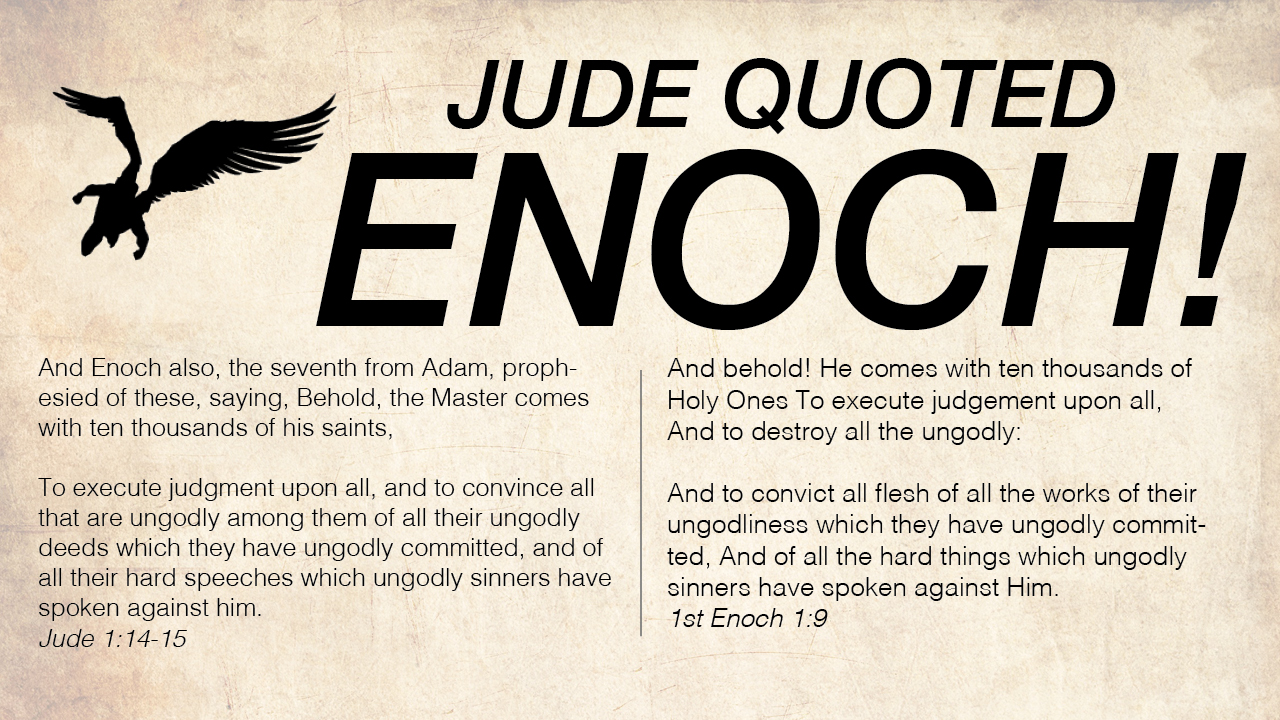
In fact, Messiah teaches from 1st Enoch 15 when challenged by the Sadducees regarding marriage in heaven in Matthew 22 (link). Ponder this for a moment, after spending time with the Word of YHWH himself (Messiah), Peter and Jude would have been warned about 1st Enoch if it wasn’t inspired, or if it was just fables, or even an evil book. But to stay on topic, we must remain brief here. Here’s a playlist if you’re interested in learning more about 1st Enoch:
The point is, the calendar is detailed in 1st Enoch, that’s just where YHWH decided to preserve it.
Enoch 72 – The Sun – Witness #1

Enoch 72 begins the teaching regarding the calendar via the heavenly luminaries.
The book of the courses of the luminaries of the heaven, the relations of each, according to their classes, their dominion and their seasons, according to their names and places of origin, and according to their months, which Uriel, the holy angel, who was with me, who is their guide, showed me; and he showed me all their laws exactly as they are, and how it is with regard to all the years of the world and unto eternity, till the new creation is accomplished which endures till eternity. And this is the first law of the luminaries: the luminary the Sun has its rising in the eastern portals of the heaven, and its setting in the western portals of the heaven
Enoch 72:1-2
Notice Enoch agrees with Genesis 1:14
The lights in the heavens tell time (seasons, months, years). Also, that the first law regarding timekeeping is in the hands of the sun.
And first there goes forth the great luminary, named the Sun, and his circumference is like the circumference of the heaven, and he is quite filled with illuminating and heating fire.
Enoch 72:4
Now for the first rule.
In this way he rises in the first month in the great gate, which is the fourth
Enoch 72:6

Wouldn’t it make sense that the first rule regarding the calendar would be in direct relation to the starting of the new year? Now, we need to understand what the fourth portal is in relation to the sun’s position. We believe the fourth gate is the equator (spring equinox). Let’s test that.
When the sun rises in the heaven, he comes forth through that fourth gate thirty mornings in succession, and sets accurately in the fourth gate in the west of the heaven. And during this period the day becomes daily longer and the night nightly shorter to the thirtieth morning
Enoch 72:8-9
This is exactly what happens when the sun crosses the equator, known as the equinox. For those of us in the northern hemisphere (as Jerusalem also is), we experienced long nights and short days during winter. However, as the sun approaches the equator (spring equinox), the nights become shorter and the day longer. As in, there will be more than twelve hours of daylight, and less than twelve hours of night.
…in the fourth gate in the west of the heaven. And during this period the day becomes daily longer and the night nightly shorter to the thirtieth morning
Enoch 72:8-9
Here’s a quick snapshot of sunrise, sunset and daylight times in Jerusalem:
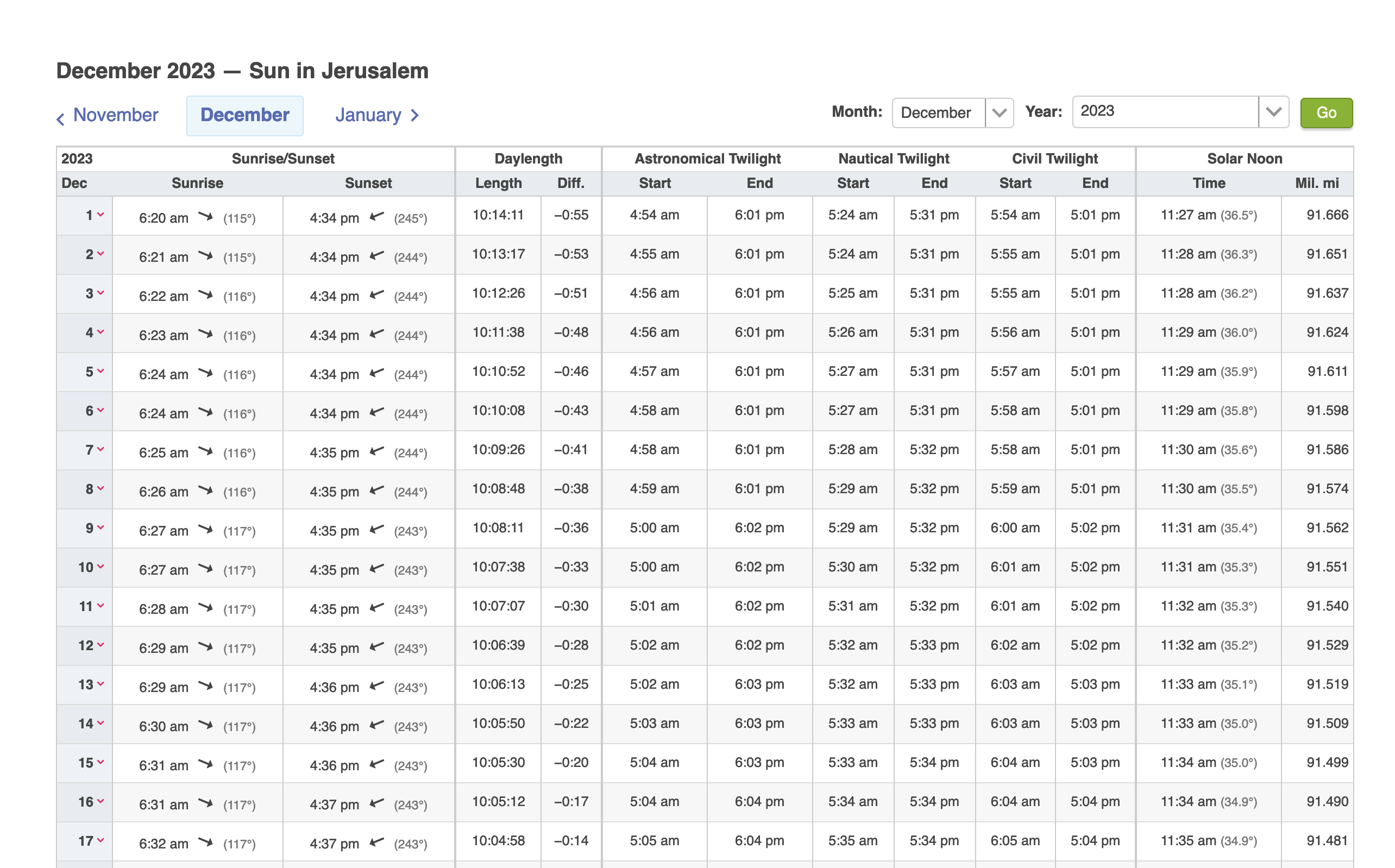
Winter
Notice the amount of daylight decreases each day during winter (as the sun goes farther away from the equator).
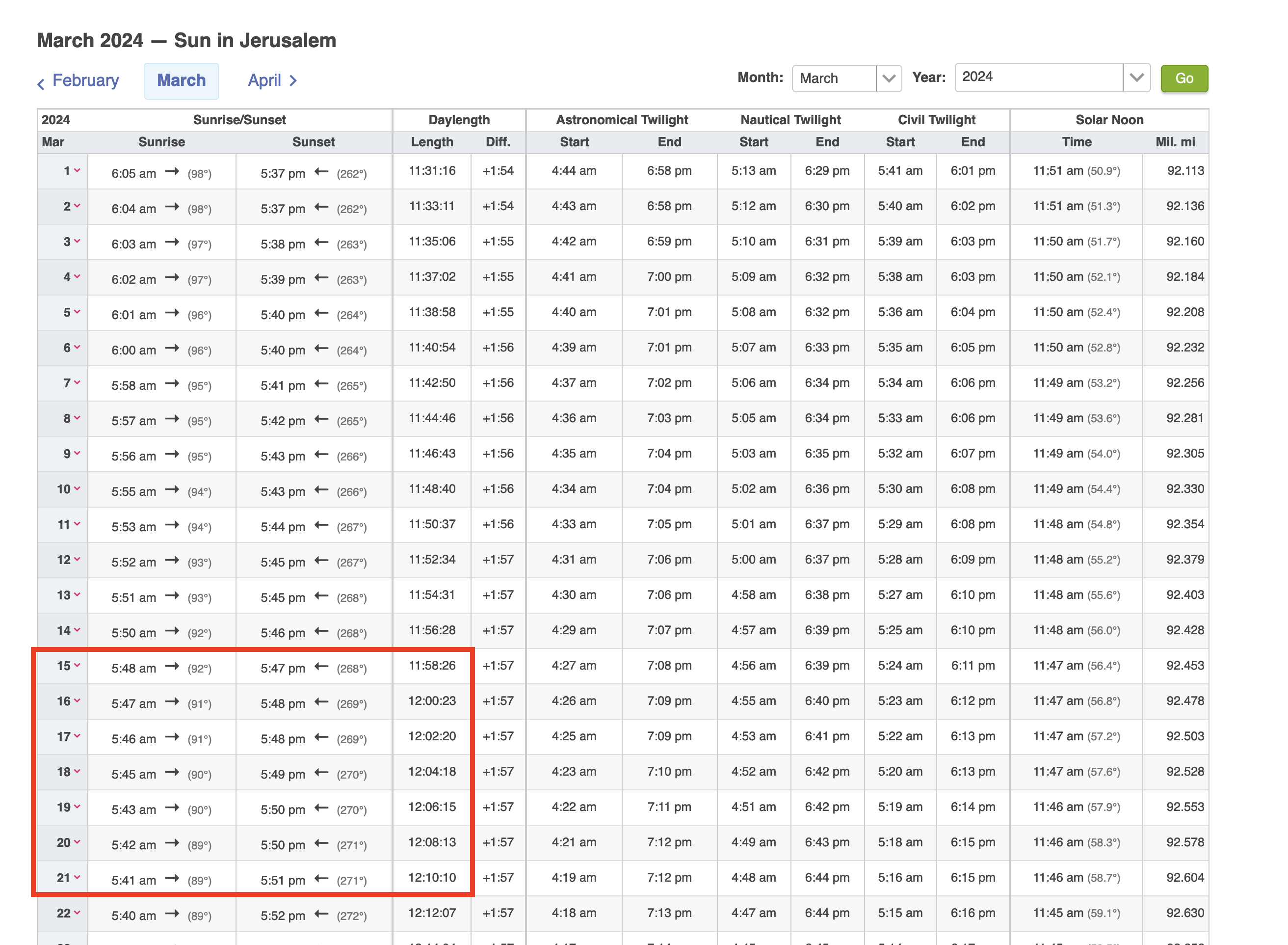
Now here around the spring equinox, we see the daylight hours overtake the night, as in, there’s more daylight than night time. This confirms the fourth gate is the equinox (sun crossing the equator). Note, for an exact change from twelve hours of daylight and twelve hours of night, one must be residing on, or near the equator.

So, according to the first ordinance of the new year, the sun must be in the fourth gate, also known as the spring equinox transpiring. This makes sense, as beginning the year in spring truly relates to observing abib (springtime). Wouldn’t that make more sense than spotting barley and sometimes beginning the new year in winter (as many did this year – no offense).
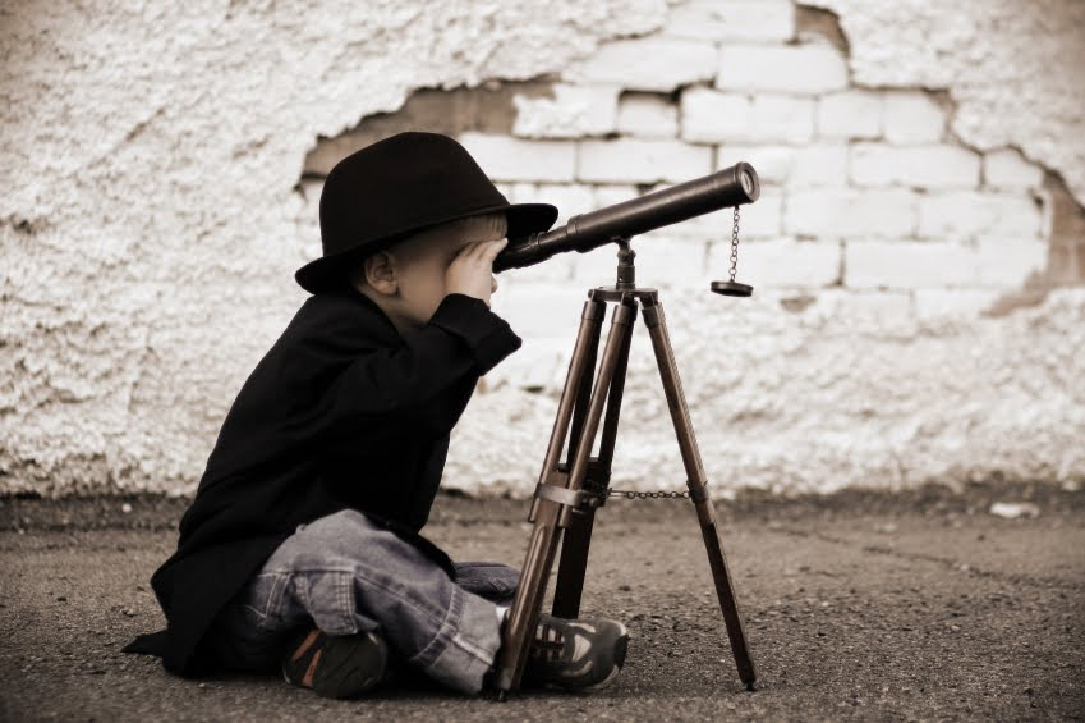
Some have said the ancient Israelites wouldn’t have been able to pinpoint the equinox without modern technology. Here, in this article, you’re quickly reminded how nearly every ancient civilization was able to do so, much of the evidence still carved in stone today. If pagan nations were able to easily determine it, how much more so the children of the Most High? Here’s an article showing us how easy it is for us even today to spot the equinox without technology.
Observing Abib witness number one confirmed, the sun.
Enoch 73 – The Moon – Witness #2

And after this law I saw another law dealing with the smaller luminary, which is named the Moon
Enoch 73:1
Now the details of the moon.
And her rising and setting change every month: and her days are like the days of the sun, and when her light is uniform (i.e. full) it amounts to the seventh part of the light of the sun. And this is how she rises. And her first phase in the east comes forth on the thirtieth morning: and on that day she becomes visible, and constitutes for you the first phase of the moon on the thirtieth day together with the sun in the portal where the sun rises. And the one half of her goes forth by a seventh part, and her whole circumference is empty, without light, with the exception of one-seventh part of it, (and) the fourteenth part of her light.
Enoch 73:3-4

Here a few things are confirmed. The first visible light (sliver) is equated to the first phase of the moon and therefore should be the new moon. We get more confirmation of this in Enoch later. Also, when it states “the first phase of the moon on the thirtieth day together with the sun in the portal where the sun rises” shows us these two (sun and moon), work together, and are the two witnesses for observing Abib.
And the Moon conducts the years exactly, all of them according to their eternal positions; they are neither early nor late, even by one day, but change the year in exactly 364 days. In three years, there are 1,092 days, and in five years 1,820 days, so that in eight years there are 2,912 days.
Enoch 74:12-13 (Ethiopic)
This is how YHWH’s calendar functions, the sun and moon work together, much like an hour and minute hand work in tandem on a clock. Now we know the moon is witness #2 in beginning the new year (observing Abib). Also, the quest for the 364 day calendar is revealed here, “but change the year in exactly 364 days”. I believe this gives gives credibility to the 13th month (“change the year in exactly 364 days” is another way for saying intercalation). Also, here’s another reason why. Immediately following the statement “but change the year in exactly 364 days”, Enoch instructs us in three years there is 1,092 days. Let me ask you, do you think he’s telling us this because we cannot multiply 364 x 3, or add 364 three times? Or is there more to it?
364 x 3 = 1,092 (three years)
We know the moon comes in 10 days earlier than the sun every year, giving it a 354 day circuit for a lunar year.
For the moon alone the days amount in 3 years to 1062 days
Enoch 74:14
354 + 354 + 354 = 1,062
When calculating the new year (observing Abib), based on the sun crossing the spring equinox as witness number one and the prerequisite for number two, and then beginning the new year based on the first visible sliver of the moon (witness number two) will give a three year result like this:
Year 1: 354 days
Year 2: 354 days
Year 3: 384 days – 13th month added because the sun had not yet crossed the spring equinox. Each year the new year falls behind 10 days until it needs to be “changed”, or intercalated as Enoch recorded. Take 2024 for example. The potential new year (moon) came on March 11, nine days before the spring equinox. This is why we added the 13th month and decided not to begin the year in winter.
354 + 354 + 384 = 1,092 (1,092 divided by 3 years = 364 days)
This, brothers and sisters is how we truly can observe a 364 day calendar without fail. Something the solar calendars advertise, however in practical application, it never can average out to 364, because the sun has a 365.24 day circuit. No matter how you intercalate a solar calendar, the rolling average will always be 365.24, because there is only one factor in play, the sun.
The year then becomes truly complete according to the station of the moon, and the station of the sun; which rise in the gates; which rise and set in them for thirty days.
Enoch 74:16
Above, we get clear confirmation that the biblical year is calculated using both the sun and moon. In examining the Ethiopic translations, they all say the same, the year truly becomes complete based off the sun and moon. The popular R.H. Charles translation (which I enjoy reading from) says something different, causing confusion:
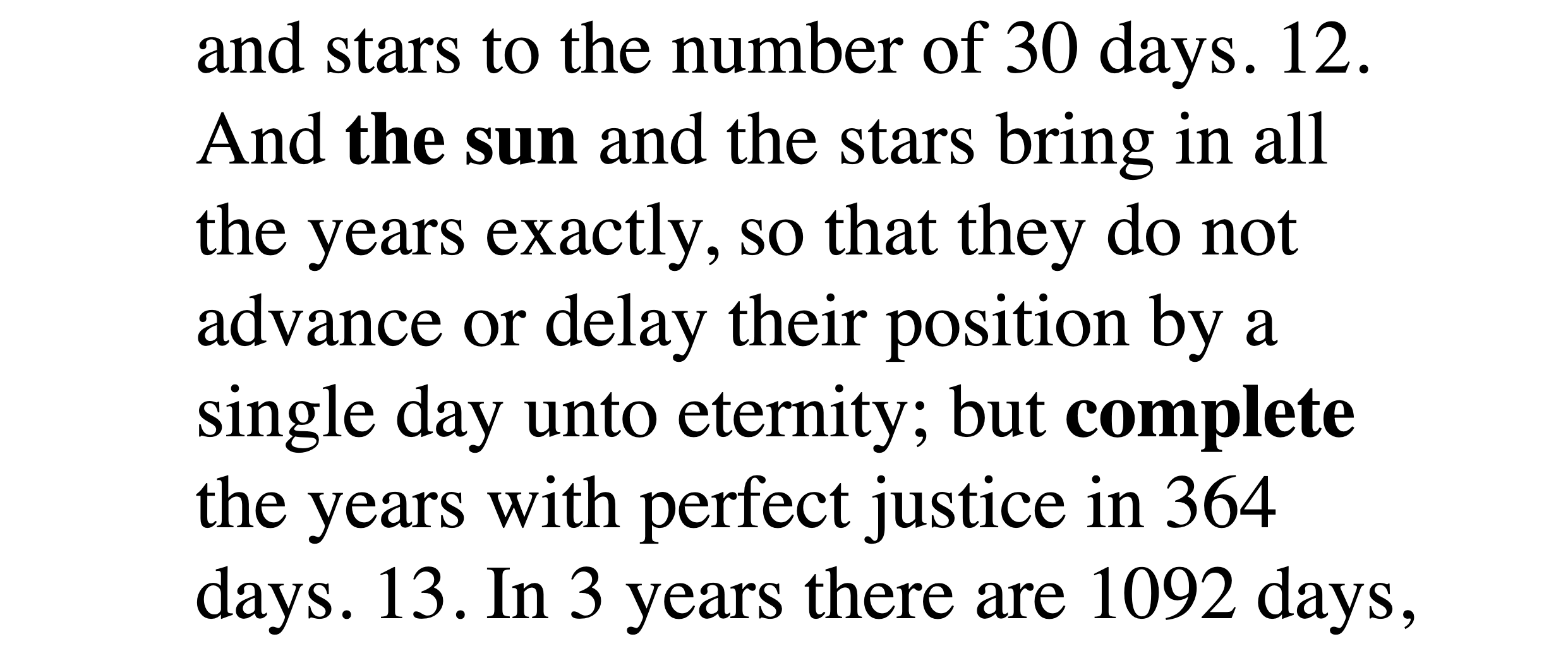
How confusing! The Ethiopic translations all say moon and sun, however this translation says the sun and stars. Let me share with you why. Here is part of the translators preface for the R.H. Charles translation:

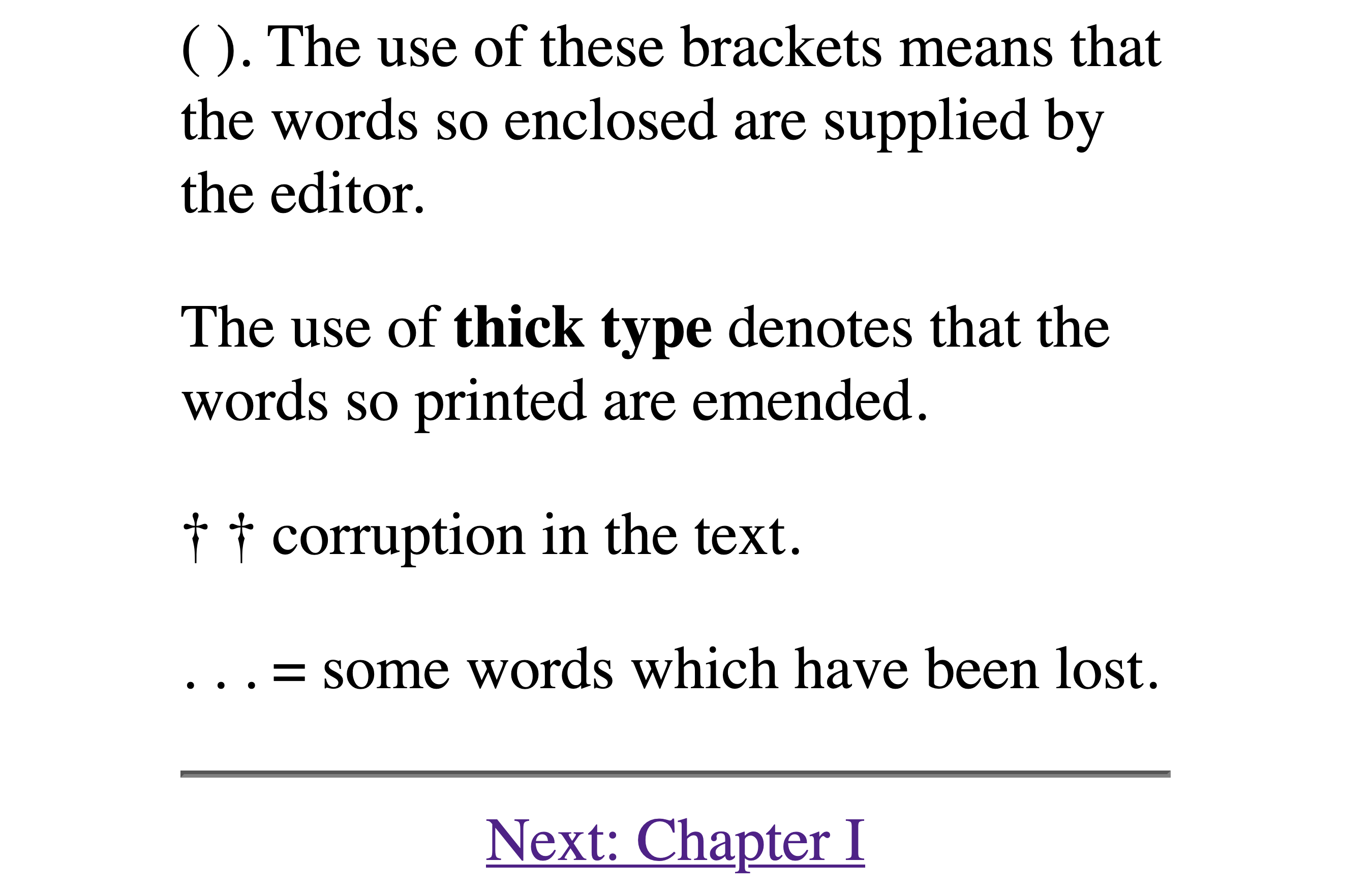

I do not suspect any malicious intentions, however I do believe the editor attempted to alter the text to suit their understanding regarding the calendar.
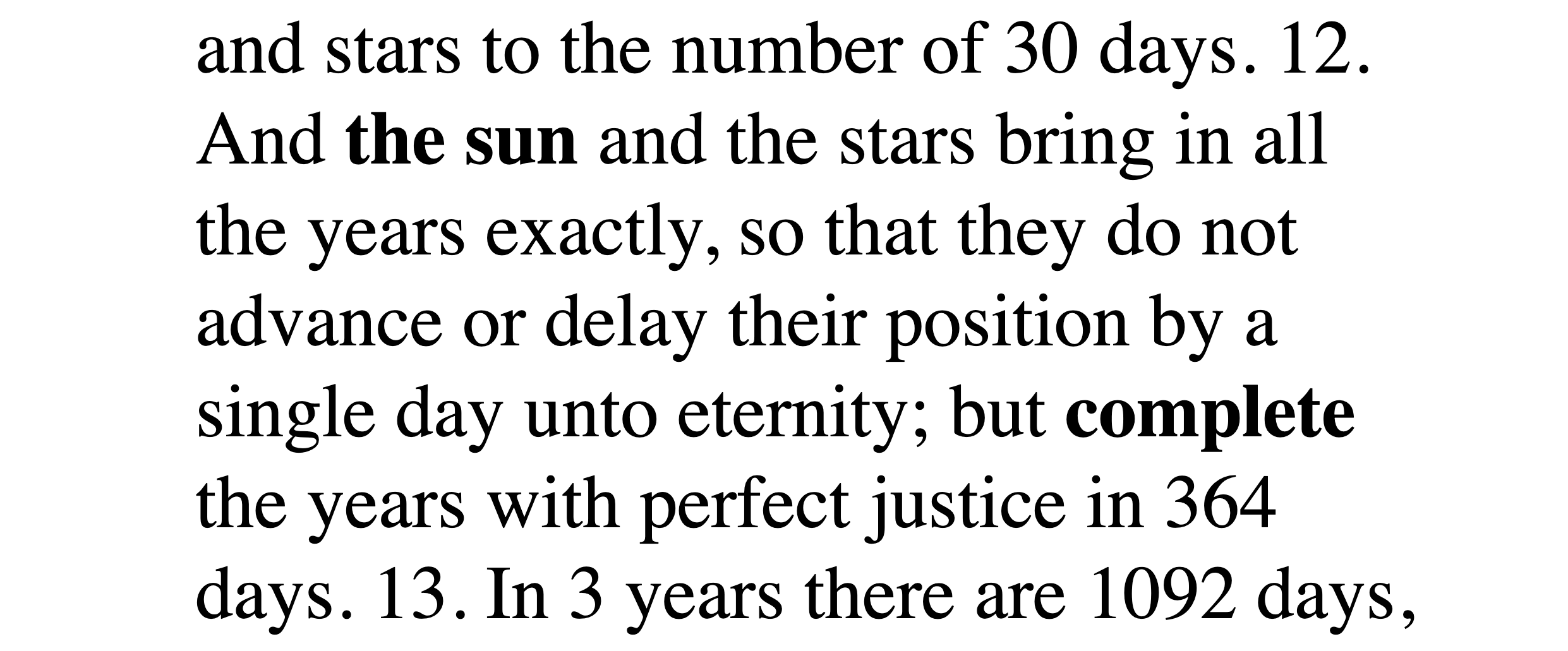
Sun should really be ‘moon’, and complete should be ‘changed’, as all the other translations state.
Now, just a few more verses to finish regarding the moon:
And when the Moon rises, it appears in the sky, and has a half of a seventh part of light, and on the fourteenth day it makes all its light full
Enoch 78:6
Here is more evidence for the first visible sliver beginning the month.
And on the first day it is called the New Moon, for on that, light rises on it
Enoch 78:12

Connecting verse 6 and 12 above confirms the new moon sliver as the first phase, or new moon/month.
On the side whence the light of the moon comes forth, there again she wanes till all the light vanishes and all the days of the month are at an end, and her circumference is empty, void of light.
Enoch 78:14
Blank or conjunction (dark) moon is referenced here as the last day of the month, also approving of the first sliver as the first phase.
It is our conclusion that the sun is witness number one, followed by the moon as witness number two in ‘observing Abib’. Consequently, the barley will always be there, as the first month will always be positioned in springtime, and not winter. After all, the barley harvest must be fully ripe and ready for cultivation for the required offering, and to provide grain for the week of unleavened bread! Furthermore, keep in mind cultivating and processing the barley fields were a lot of work and took time. All the preparation needed to be done before all the males had to report to Jerusalem for the festival, which remember, was not optional.
“Three times in a year shall all thy males appear before YHWH your Elohim in the place which he shall choose; in the feast of unleavened bread, and in the feast of weeks, and in the feast of tabernacles: and they shall not appear before YHWH empty:”
Deuteronomy 16:16
Spotting half-ripe barley fields in winter and stating it would be ready by Passover in two weeks wouldn’t cut it. Farmers would need to wait for the whole field to be ripe, then harvest, then dry, then process, then travel to Jerusalem.
Speak unto the children of Israel, and say unto them, When ye be come into the land which I give unto you, and shall reap the harvest thereof, then ye shall bring a sheaf of the firstfruits of your harvest unto the priest
Leviticus 23:10

This year (2024) is a perfect example. There were scattered reports about the barley harvest. Some saying it was partially ripe, others saying the wild barley was ripe, but not the main field. This is quite chaotic to be honest, and not solid ground for maintaining a rolling 364 day calendar.
HISTORICAL RECORDS

I believe we have put forth the case for the use of the luminaries instead of the barley for ‘observing Abib’. However, I’d like to finish with a few last pieces of evidence from historical records. What you’ll notice, the spring equinox is the prerequisite for Passover and the new year. I do not hold this evidence with the same weight as scripture, however I believe it is relevant to the discussion.

“And this is not an opinion of our own; but it was known to the Jews of old, even before Christ, and was carefully observed by them. This may be learned from what is said by Philo, Josephus, and Musæus; and not only by them, but also by those yet more ancient, the two Agathobuli, surnamed ‘Masters,’ and the famous Aristobulus, who was chosen among the seventy interpreters of the sacred and divine Hebrew Scriptures by Ptolemy Philadelphus and his father, and who also dedicated his exegetical books on the law of Moses to the same kings. These writers, explaining questions in regard to the Exodus, say that all alike should sacrifice the passover offerings after the vernal equinox, in the middle of the first month. But this occurs while the sun is passing through the first segment of the solar, or as some of them have styled it, the zodiacal circle. Aristobulus adds that it is necessary for the feast of the Passover, that not only the sun should pass through the equinoctial segment, but the moon also. For as there are two equinoctial segments, the vernal and the autumnal, directly opposite each other, and as the day of the Passover was appointed on the fourteenth of the month, beginning with the evening, the moon will hold a position diametrically opposite the sun, as may be seen in full moons; and the sun will be in the segment of the vernal equinox, and of necessity the moon in that of the autumnal [equinox].“
(Eusebius’ Ecclesiastical History, Book 7, Chapter 32, http://www.newadvent.org/fathers/250107.htm)
To seven he gives the chief feasts prolonged for many days, two feasts, that is for the two equinoxes, each lasting seven days, the first in the spring to celebrate the ripeness of the sown crops, the second in the autumn for the in-gathering of all the tree-fruits…”
(Philo, The Decalogue (161) [Colson’s Translation])

“At the first season which name he gives to the springtime and its equinox, he ordained that what is called the feast of unleavened bread should be kept for seven days, all of which he declared should be honored equally in the ritual assigned to them. For he ordered ten sacrifices to be offered each day as at the new moons, whole-burnt offerings amounting to seventy in all apart from the sin offerings. He considered, that is, that the seven days of the feast bore the same relation to the equinox which falls in the seventh month as the new moon does to the month.”
(Philo, Special Laws I (181-182) [Colson’s Translation])
But nothing was difficult to them with whom it was lawful to celebrate the Passover on any day when the fourteenth of the moon happened after the equinox. Following their example up to the present time all the bishops of Asia—as themselves also receiving the rule from an unimpeachable authority, to wit, the evangelist John, who leant on the Lord’s breast, and drank in instructions spiritual without doubt—were in the way of celebrating the Paschal feast, without question, every year, whenever the fourteenth day of the moon had come, and the lamb was sacrificed by the Jews after the equinox was past.”
(Ante-Nicene Fathers Vol. VI, The Paschal Canon of Anatolius of Alexandria)

According to Eusebius, long before Christ, the Jews anciently (as attested to by Philo, Josephus, Masaeus, the two Agathobuli, and Aaristobulus, who was one of the 70 Jewish scholars who translated the Septuagint) sacrificed the Passover lamb after the vernal equinox, in the middle of the first month.
(Ecc. Hist., book 7:16–19, emphasis added).
Thus Passover must be celebrated in the month of Nisan, called in the Bible the month of Abib [barley] (spring), and never before the vernal equinox.”
(The New Jewish Encyclopedia, p. 70, Behrman House Publishers; 1976, emphasis added)

Brothers and sisters, none of this matters if we are not walking in faith and obedience to YHWH. While the calendar is important, let us remind ourselves that there are weightier matters. This is a critical time to remove the leaven from our lives and be prepared to meet our maker. Another reminder, YHWH also instructed us that the sun and moon would be for signs. We very well could be at the end of days.
And there shall be signs in the sun, and in the moon, and in the stars; and upon the earth distress of nations, with perplexity; the sea and the waves roaring; Men’s hearts failing them for fear, and for looking after those things which are coming on the earth: for the powers of heaven shall be shaken. And then shall they see the Son of man coming in a cloud with power and great glory. And when these things begin to come to pass, then look up, and lift up your heads; for your redemption draws nigh
Luke 21:25-28
With this in mind…
But the day of YHWH will come like a thief, in which the heavens will pass away with a roar and the elements will be destroyed with intense heat, and the earth and its works will be burned up. Since all these things are to be destroyed in this way, what sort of people ought you to be in holy conduct and godliness, looking for and hastening the coming of the day of Elohim, because of which the heavens will be destroyed by burning, and the elements will melt with intense heat! But according to His promise we are looking for new heavens and a new earth, in which righteousness dwells. Therefore, beloved, since you look for these things, be diligent to be found by Him in peace, spotless and blameless
2 Peter 3:10-14
Lastly:
Follow peace with all men, and holiness, without which no man shall see YHWH: Looking diligently lest any man fail of the grace of Elohim; lest any root of bitterness springing up trouble you, and thereby many be defiled
Hebrews 12:14-15
It is our hope that this study was a blessing in some way. Even if we don’t agree, perhaps you are able to understand where we are coming from. If you’d like to learn more about the 364 day luni-solar calendar we use, here are some links:
Calculating the Feast Days (Video Link)
Calculating the Feast Days (Article Link)
FREE CALENDAR DOWNLOAD
2024-2025 Downloadable Calendar PDF
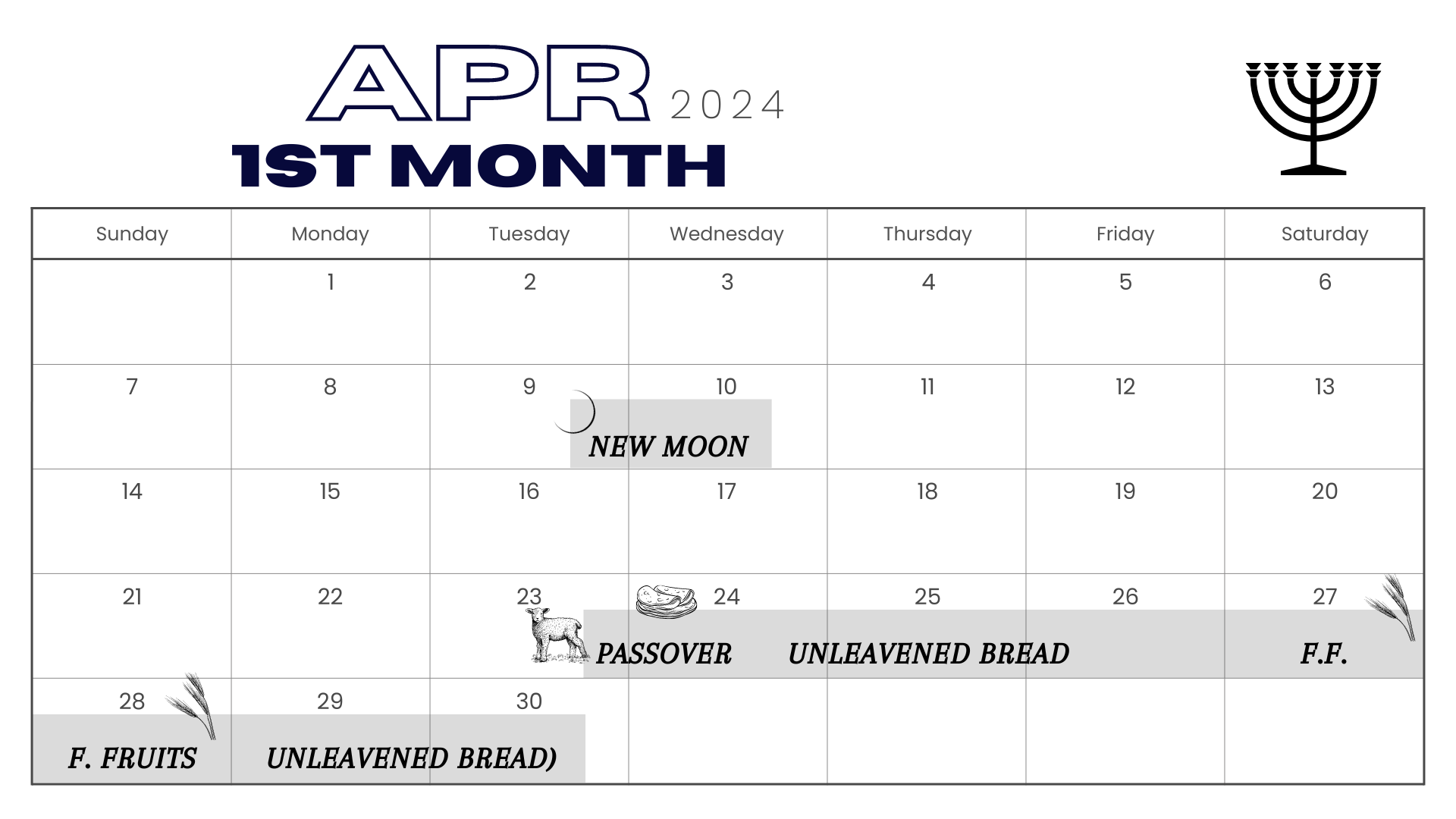
New moon (biblical new year): Evening of Apr 9th. Spot the new sliver at sunset in the west
Passover Meal: Evening (Sunset) on the 23rd of Apr
Week of Unleavened bread: (Begins with the Passover Meal) Evening of the 23rd of Apr to Apr 30th at evening.
Sabbaths: Evening of 23rd to evening of 24th & evening of 29th to evening of Apr 30th.
If you’d like to join us for Passover, click this link
May YHWH bless you and keep you,
YHWH make his face shine upon you and be gracious to you,
YHWH lift up his countenance upon you, and give you shalom (peace).



